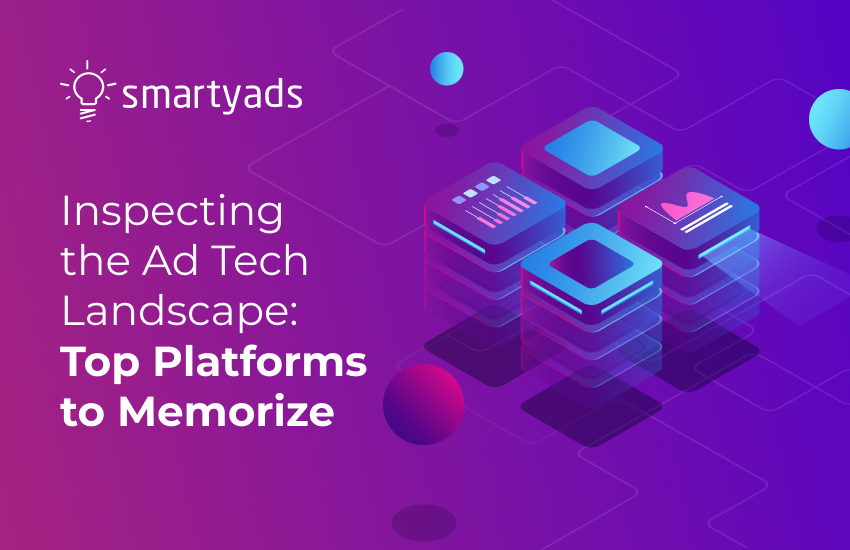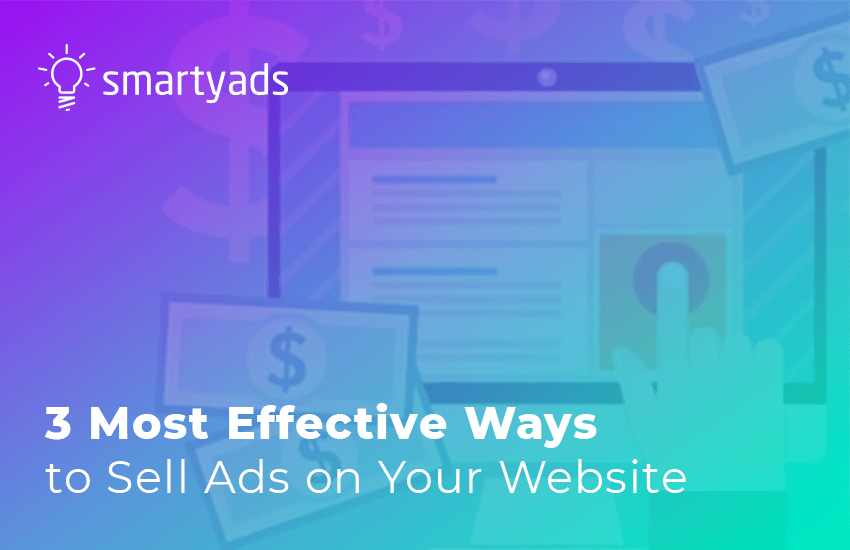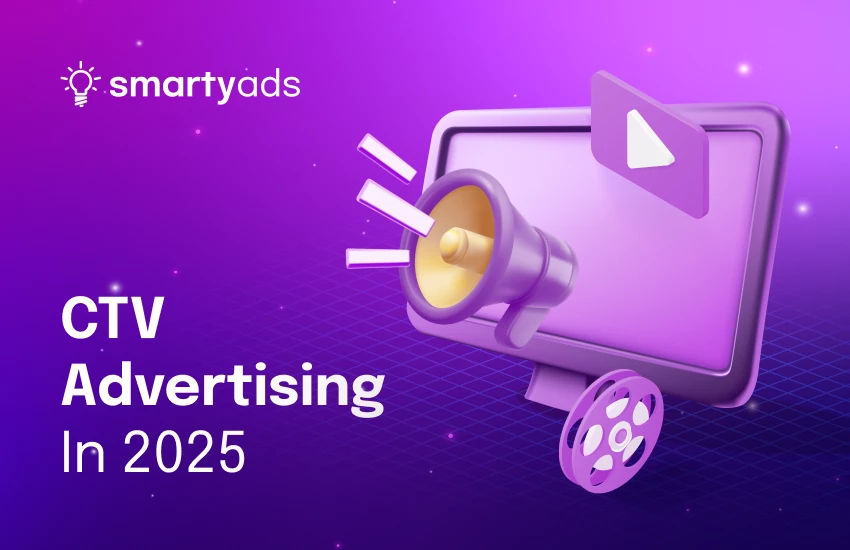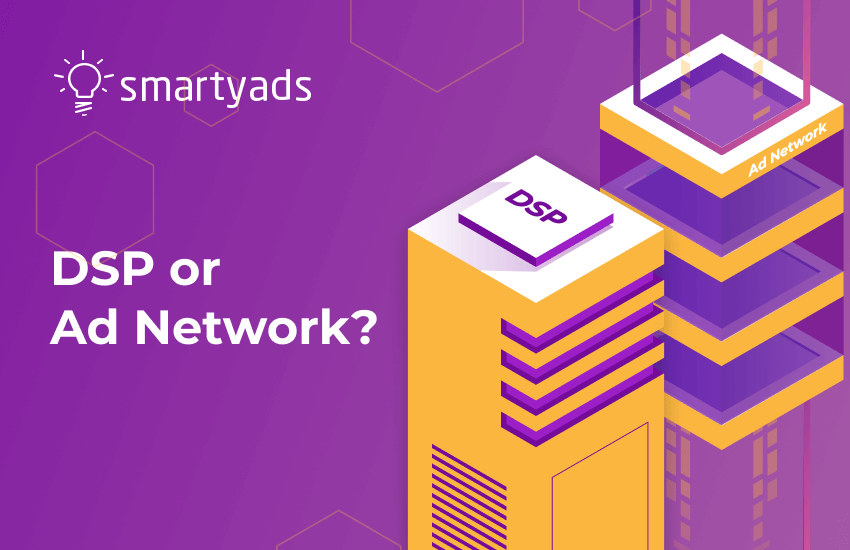Marketing technology today offers huge opportunities for advertising any product or brand. With just a few clicks, you can set up digital advertising campaigns that can bring you customers and revenue, boost the effectiveness of ad spend, and so on. The number of solutions and advanced tools to accomplish these tasks is constantly increasing.
Ad campaigns are no longer possible without special software. You've probably heard the term "ad tech", which has combined a variety of different types of digital tools for ad campaign management and data analysis. Our article is about what ad tech industry is and how it works in programmatic advertising.
What is ad tech
Ad tech is a general term that includes all kinds of tools and software platforms for setting up and showing ads to potential customers. Using advertising technology, advertisers collect massive amounts of audience data, more accurately define the target audience, set targeting parameters, optimize ad spend, and evaluate the return on investment of the ad campaign.
Based on the information about consumers, advertising technology enables advertisers to personalize advertising communications, showing ads to interested audiences at a time when they are most receptive to programmatic advertising.
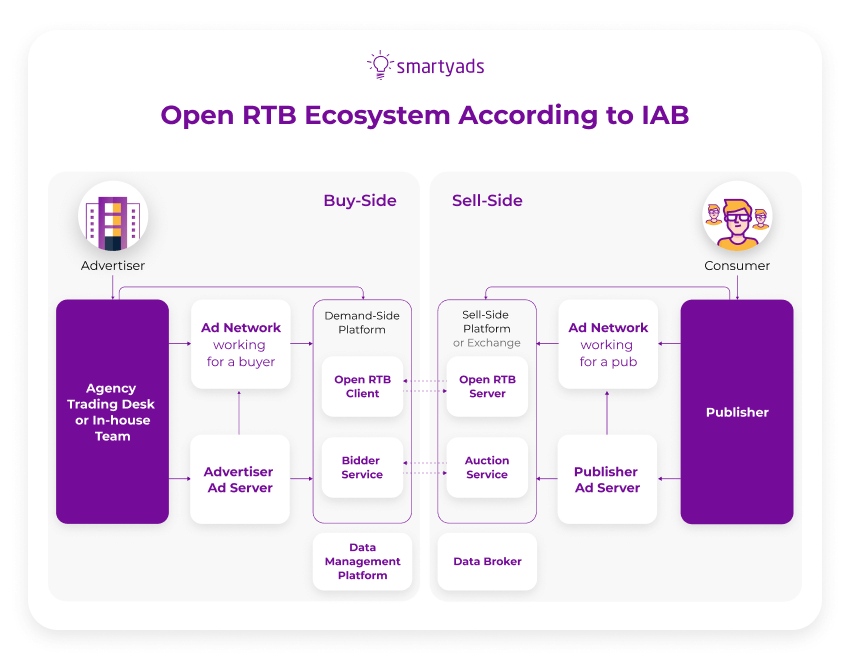
Why do we need ad tech in digital advertising?
To answer this question, you need to remember a time when advertising messages were shown to as many users as possible in the utmost channels. This digital marketing strategy can be effective in some cases: for example, to increase brand awareness, to introduce new products, etc. However, this approach is far from perfect.
Programmatic advertising designed for a wide audience will always be insufficiently relevant to each individual consumer. In this situation, it is difficult to find a personalized approach to customers, to show the message at the right time (or in the right place), and to establish a real connection with them. As a result, the effectiveness of such digital advertising is low at a high cost.
But with ad tech, ads are always delivered to the most relevant audience at the right time, on the right resource, and in the most appropriate context.
With ad tech, advertisers save time and money, publishers and app developers get the opportunity to monetize their digital assets, and users get the most useful and relevant offers.

Ad tech tools
Many advertising technologies are used to support advertising initiatives.
Here are a few of the most popular
Supply Side Platform (SSP)
A supply-side platform is software for selling ad inventory. It helps sites effectively monetize audiences and optimize ad impressions. With this platform, publishers can place their available ad space on various ad exchanges, DSPs, and other networks. As soon as the ad exchange receives a new offer from the site owner, the demand-side platform (DSP) buys it out as a brand.
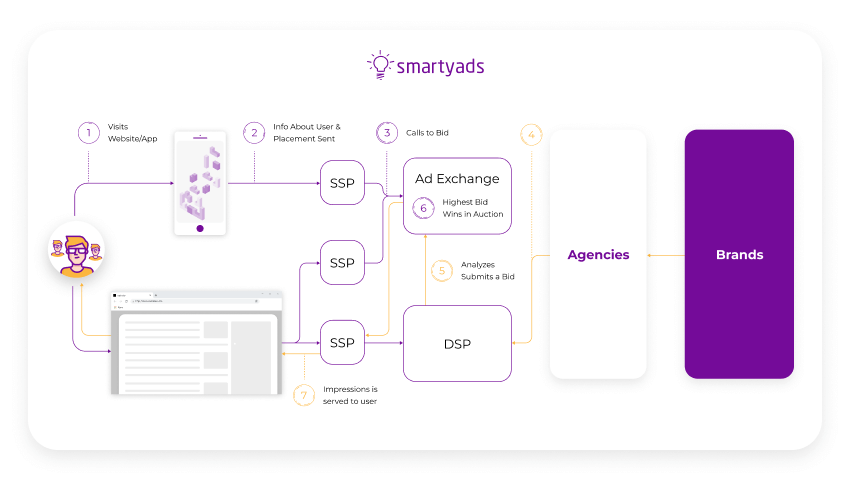
This takes into account pre-established selection criteria. For example, exactly where on the page the ad will be shown and who will see it. The point of the process is that as many brands as possible will see the offer from the site. To buy impressions on that site, the brand participates in an auction named real-time bidding (RTB). This way, the site owner can choose who will show up on their site, at what price, and at what location.
In recent years, SSPs have become very sophisticated in displaying audience segments, advertiser requests, and campaign performance analysis. For publishers, this information is very valuable because it allows them to build their content strategy in the most profitable way.
Best SSPs for 2022-2023:
- SmartyAds SSP;
- OpenX;
- PubMatic;
- Google Ad Manager;
- Sovrn;
- Index Exchange;
- SpotX;
- Teads;
- Vistar Media.
Demand Side Platform (DSP)
This is the opposite side. Through demand-side platforms, ad agencies and advertisers buy displays (ad inventory), optimize ad placements, and analyze and manage ad campaigns. A demand-side platform is an automated way to buy ad space.
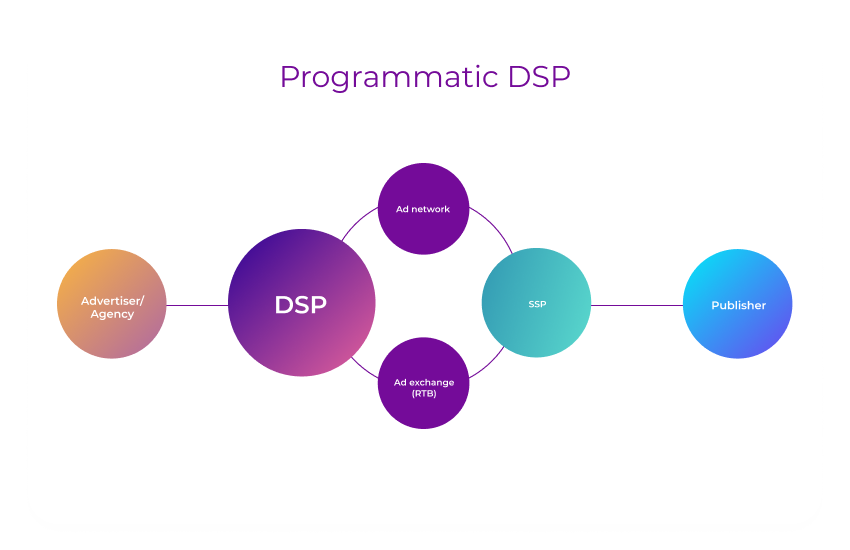
With demand-side platforms, media buying is much easier for advertisers; they can buy ad space from different sites and media owners.
Only those users who match the brand's needs are offered for ad buying. Previous online interests, geolocation, or other options important to the brand are taken into account.
Site owners, in turn, submit their offers to the SSP. After that, the request is sent to the ad exchange, which selects the best option for a particular advertiser. And then, the demand-side platform analyzes all the possibilities and gives the best ones.
Bids for displays are determined by real-time bidding in milliseconds.
Best DSPs for 2022-2023:
- SmartyAds DSP;
- Display & Video 360 (DV360);
- Amazon DSP;
- MediaMath;
- OneView;
- Xandr Invest;
- Yahoo! Ad Tech;
- RhythmOne.
Agency Trading Desk (ATD)
Agency Trading Desk (ATD) is a set of services provided by ad agencies. ATD is needed to plan, buy, and manage advertising on various platforms. Somehow, it's a mini-version of the DSP, since it performs a small part of its functions.
This solution is suitable for advertisers who are not ready to invest in a DSP or expand their sales teams. However, keep in mind that the ATD's capabilities are severely limited compared to the demand-side platforms and it cannot provide the highest quality ad inventory.
Customer data platform (CDP)
The Customer Data Platform (CDP meaning) is a part of the software that combines data from multiple tools to create one centralized customer database. This database contains information about all the touchpoints and interactions with your product or service. Customer data platforms can then be segmented in an almost infinite number of ways to create more personalized marketing campaigns.
Best Customer Data Platform for 2022-2023:
- Insider;
- Bloomreach;
- Klaviyo;
- Segment;
- Emarsys.
Ad exchanges
An ad exchange is a virtual marketplace where advertisers meet with website publishers to buy advertising space. Often such communication is based on real-time auctions. Advertising formats can range from desktop banner ads to mobile ads.
Digital trading platforms that collect publishers' supply-side platform (SSP) bid and advertisers' demand-side platform (DSP) demand for ad impressions. Media buying and selling occur in real-time auctions using RTB (real-time bidding) technology.
As soon as a user enters the site, an auction is organized on the ad exchange platform. The buyer's platform performs an instant analysis of previous interactions, the interests of that site visitor, and bids for the display. The size and appropriateness of the bid are based on the relevance of the characteristics of the site visitor.
Private ad exchanges
A private ad exchange or private marketplace (PMP) is a closed system in which the publisher controls the entire process.
The publisher can decide which buyers can bid and what the starting price and bidding conditions will be. Each private ad exchange is managed by the publisher, who can invite each buyer.
In such an exchange, the publisher can give permission for certain buyers or media agencies to bid, and can also deny all outside bidders access to their display data. Private marketplaces facilitate direct agreements between brands and advertising platforms, which is impossible with open ad exchanges.
Best Ad Exchanges for 2022-2023:
- SmartyAds as an Ad Exchange;
- OpenX as Ads Exchange;
- Rubicon Project;
- PubMatic as an Ad Exchange;
- MoPub as an Ads Exchange;
- Index Exchange;
- Smaato;
- Google AdX.
Ad Networks
An ad network is a complex of advertising platforms, united by a single system of advertising placement.
An ad network is a media-neutral term, although it is often used to refer to an "Online Ad Network". What distinguishes Online Ad Networks from traditional ad networks is that online advertising is delivered to the public through an Ad Server. Placing ads through one central core provides the business owner with a variety of audience targeting, tracking, and reporting methods that traditional media alternatives don't have.
Ad networks work with publishers over the Internet. Such a network can help those who have untapped resources or advertising platforms and those who want to monetize their offers. The ad networks then aggregate these resources, package them up, and sell them to advertisers.
Advertising networks can be of various types: horizontal, vertical, and premium. Now we'll tell you a little bit about all of them.
Horizontal
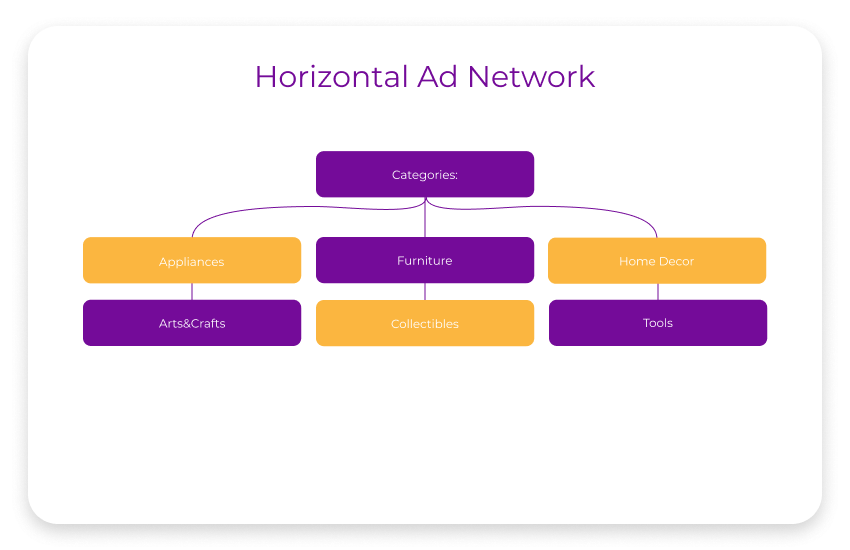
Such advertising networks work with many publishers and the entry threshold is quite low, so it is very easy for a publisher to get into it.
However, such networks work mostly on the CPC model, which means that payment will be made only if the user clicks on the ad. Such networks are good for advertising campaigns with a small budget, but you should keep in mind that their targeting is not the most accurate.
Vertical
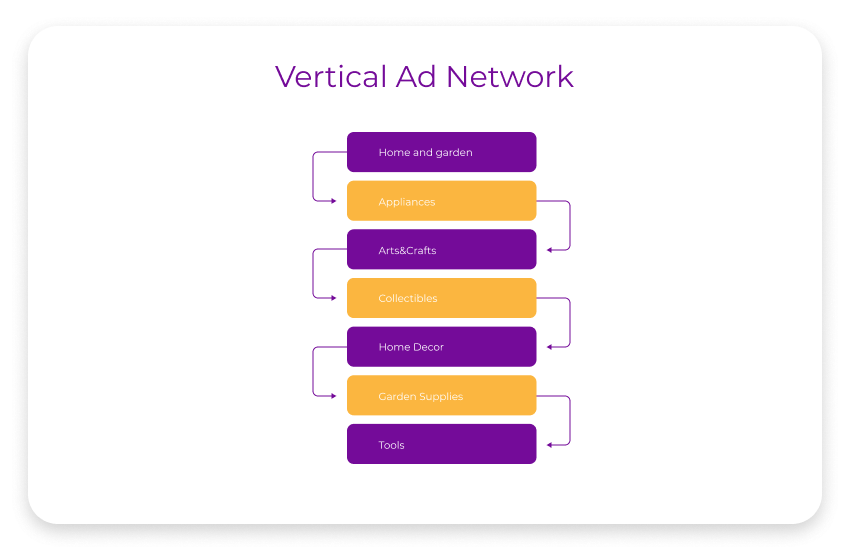
Vertical ad networks are set up for high-precision niche targeting, so they are more likely to bring in conversions, but keep in mind that such ad networks may refuse to cooperate with platforms that do not fall under a certain thematic niche.
Premium
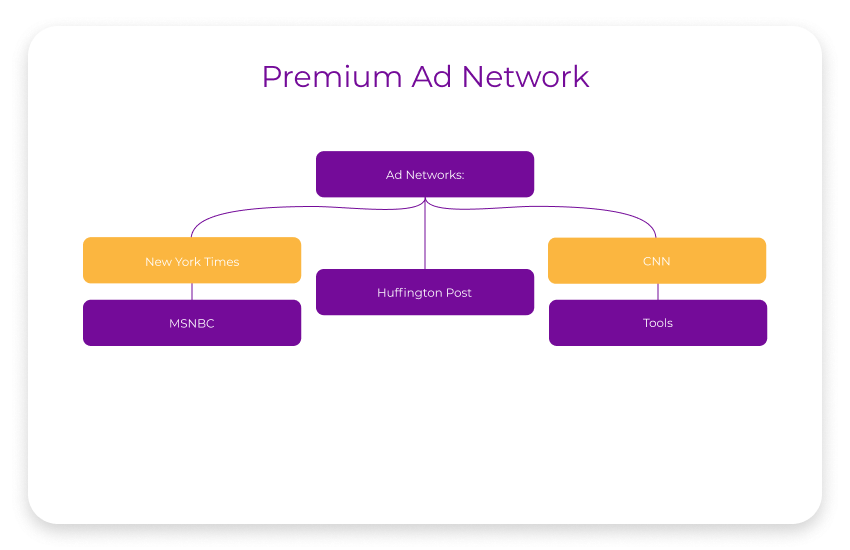
As the name implies, premium networks are kind of a step above the rest because they only work with premium publishers like The Times or Huffington Post. It's difficult to join such networks, but the quality of service will correspond.
Best ad networks for 2022-2023:
- Google AdSense;
- Amazon;
- AdRoll;
- Adsterra;
- Dianomi;
- Epom Ad Server;
- GroundTruth.
Ad servers
Ad server is a web-based technology platform and software for direct ad placement on websites.
The Ad server provides the translation of advertising material to the publisher's site, calculates the number of impressions, clicks, as well as other elements of the RTB ecosystem, and has tools for advertising campaign optimization.
Ad servers for publishers and advertisers
There are different ad servers for publishers and advertisers, but they work on the same principle: they store and sort data from one side or the other.
Publishers use ad servers to control their resources, organize ad placement, optimize ad delivery and provide statistics. And advertisers use them to control their creatives and the progress of their ad campaigns.
Self-service and managed service
It's simple, the self-service server you can control by yourself and it has more features and settings. However, it requires a significant investment in human resources. Managed service allows you to delegate this work to outsourcers and forget about this problem.
Local and remote servers
The ad server can be local or remote. A local ad server is physically accessible to you. Usually, local services are owned by the publishers. Besides local servers, there are also remote servers and you can use the capabilities of such an ad server by buying remote access to it. Usually, remote servers provide several webmasters and work independently.
Best Ad Servers for 2022-2023:
- Kevel (previously Adzerk);
- DoubleClick for Publishers (DFP) (Now Google Ad Manager);
- OpenX;
- Broadstreet.

Ad tech goals
Ad tech is based on target audience analysis, ad management, and ad delivery, and the main goal is to increase the effectiveness of programmatic advertising channels.
Ad tech is designed to:
- help advertisers and ad media agencies create, customize, measure, and manage advertising campaigns, getting the maximum return on investment;
- help publishers (owners of digital advertising space) sell impressions at the most favorable price;
- simplify the process of matching advertisers' demand and publishers' supply in advertising networks.
Current ad tech trends to improve your advertising campaigns
Advertising technologies are constantly evolving and marketers can manage online marketing campaigns that bring the most effective results. Let's talk about the most relevant ad tech trends.
Machine learning and artificial intelligence (AI)
It is the most popular advertising technology in recent years. Algorithms read and analyze data about consumers, which allows maximum fine-tuning of targeting and selection of relevant advertising content.
AI remains at the top of the list of technologies that will be developed in the near future. Getintent uses predictive technology that allows only effective ad impressions; algorithms analyze data and calculate how the user will react to it.
An important topic for all advertisers is verification, and AI can help here as well; it is able to analyze the content environment based on computer vision (CHEQ).
Big Data
Analytics is relevant at all stages of the sales funnel, so most advertisers allocate funds to Big Data. Predictive analytics is particularly worth noting; it allows you to pinpoint Target Audience action as accurately as possible.
However, it is now important not just to accumulate data, analyze it, and derive communication insights, but also to identify and audit data sources on an always-on basis.
Given the widely discussed disabling of cookies for several years now, processing large amounts of data using third-party data is becoming especially relevant.
Voice technology
Digital audio content is becoming a common attribute of life. Almost half of the Internet users listen to podcasts. Platforms try to use this opportunity and offer interactive options for advertisers besides standard solutions (trailers, playlists, etc).
For example, Google is actively testing dynamic audio advertising. For more than a year, advertisers are looking for ways to adapt voice-activated SEO to optimize sites.
According to GWI, 43% of Internet users around the world search by voice.
Gamification and interactivity
Entertainment content is very popular among users, so gamification has become the norm in almost all sectors of life, including advertising. Virtual (VR) and Augmented Reality (AR) technologies are finding their way into classic advertising formats.
There are interactive digital solutions even on TV (HBB TV, QR-codes), that can give both coverage and conversions. And, judging by the statistics, interest in such tools during the pandemic has only increased.
Nativity and contextuality
Users don't want to be distracted from the content they're interested in. Therefore, platforms offer advertisers the ability to natively embed ads into the context of a publication or branding elements into a video. It's called native advertising.
With hyper-targeting capabilities, you can create advertising effects in games and overlay dynamic banners on objects — it's all available through programmatic media buying. With today's advertising technology, it is even possible to natively integrate ads into AR/VR games.
Automating and personalizing creatives
Most marketers believe that a key brand strategy should be personalized. It's unprofitable to manually create dozens of variations of creatives, so platforms today already offer solutions for creating dynamic advertising creatives.
E-commerce everywhere
Every fourth user in the world buys a product or service via social networks; a separate area of social e-commerce has formed. The advertising possibilities of social networks are becoming limitless: shopping tags, sales through Stories, and "Buy" buttons in promotional posts are no longer rare, and platforms are constantly updating their advertising accounts for e-com purposes.
Conclusion
Ad tech technologies are the future of all advertising technologies, so for all marketers without exception, they should become as routine as the statistics on the profitability of one or another advertising campaign.
Advertising technologies are developing constantly and very fast and sometimes it is hard to keep up with them, but we and our solutions are here for you. Select your full-stack advertising platform at SmartyAds.
If you want to start enjoying all the benefits of ad tech, you've come to the right place! Contact us and let's choose a solution for you.

